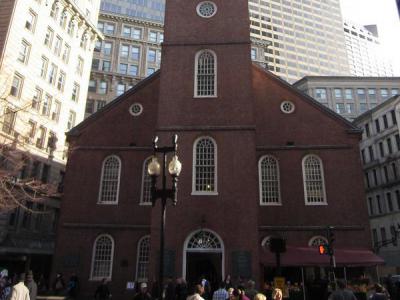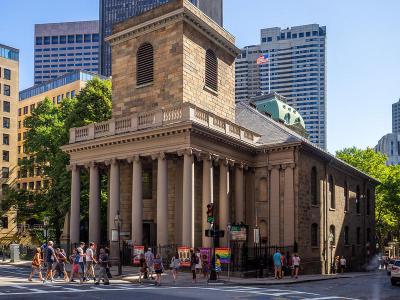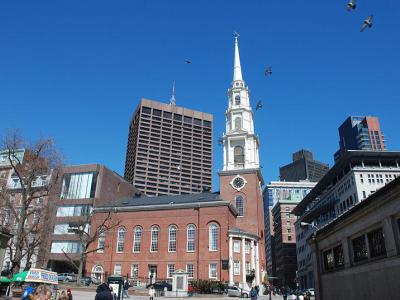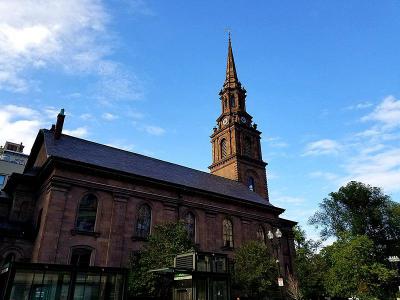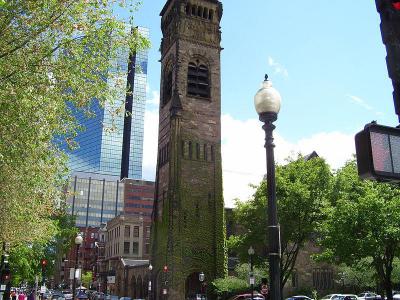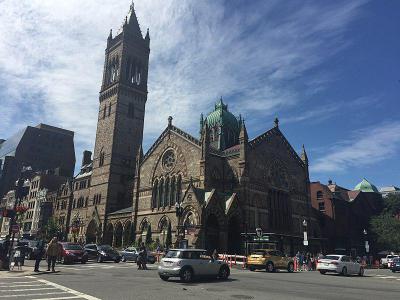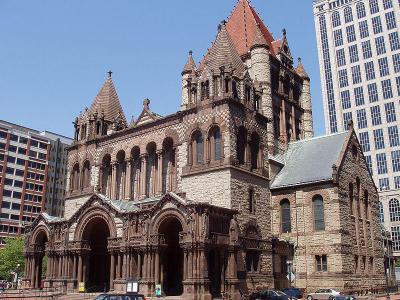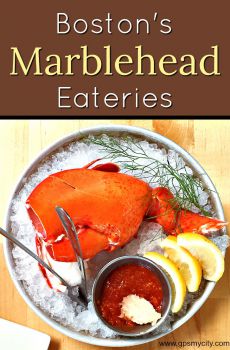Historical Churches Walking Tour (Self Guided), Boston
Boston's great churches are among the most precious of the city's numerous architectural jewels. What makes them special are their unique styles, elegant facades and long history.
Starting with the Old North Church, which towers in the city’s North End, this journey surely feels like taking a step back in time. Legend was made there, in the very place that Paul Revere waited for the famous signal; "One if by land, and two if by sea." Located in a setting filled with magnificent trees and plants, the building has been very well preserved over the years.
Next up, the King’s Chapel was the first Anglican Church in America (1686), and the construction alone – replacing the original wooden building – is worth a visit. Inside, there are plenty of design features, art, and specific adornments that make it unique.
The Tiffany art glass windows in the Church of the Covenant are another special find. For a nominal fee, you’ll receive an excellent tour of the building's numerous Tiffany stained-glass windows, and will be allowed to linger to your heart's content in the light of their majesty.
It’s really worth walking until the very end, to Copley Square, where the iconic Trinity Church immediately catches the eye. Its 19-century exterior in Romanesque style sure looks like a fairy-tale castle in the forest of high-rise modern buildings!
Take this self-guided walking tour to witness 7 wonders of Boston’s religious life. You you'll come away much richer from the experience – richer in many ways!
Starting with the Old North Church, which towers in the city’s North End, this journey surely feels like taking a step back in time. Legend was made there, in the very place that Paul Revere waited for the famous signal; "One if by land, and two if by sea." Located in a setting filled with magnificent trees and plants, the building has been very well preserved over the years.
Next up, the King’s Chapel was the first Anglican Church in America (1686), and the construction alone – replacing the original wooden building – is worth a visit. Inside, there are plenty of design features, art, and specific adornments that make it unique.
The Tiffany art glass windows in the Church of the Covenant are another special find. For a nominal fee, you’ll receive an excellent tour of the building's numerous Tiffany stained-glass windows, and will be allowed to linger to your heart's content in the light of their majesty.
It’s really worth walking until the very end, to Copley Square, where the iconic Trinity Church immediately catches the eye. Its 19-century exterior in Romanesque style sure looks like a fairy-tale castle in the forest of high-rise modern buildings!
Take this self-guided walking tour to witness 7 wonders of Boston’s religious life. You you'll come away much richer from the experience – richer in many ways!
How it works: Download the app "GPSmyCity: Walks in 1K+ Cities" from Apple App Store or Google Play Store to your mobile phone or tablet. The app turns your mobile device into a personal tour guide and its built-in GPS navigation functions guide you from one tour stop to next. The app works offline, so no data plan is needed when traveling abroad.
Historical Churches Walking Tour Map
Guide Name: Historical Churches Walking Tour
Guide Location: USA » Boston (See other walking tours in Boston)
Guide Type: Self-guided Walking Tour (Sightseeing)
# of Attractions: 7
Tour Duration: 2 Hour(s)
Travel Distance: 3.6 Km or 2.2 Miles
Author: anna
Sight(s) Featured in This Guide:
Guide Location: USA » Boston (See other walking tours in Boston)
Guide Type: Self-guided Walking Tour (Sightseeing)
# of Attractions: 7
Tour Duration: 2 Hour(s)
Travel Distance: 3.6 Km or 2.2 Miles
Author: anna
Sight(s) Featured in This Guide:
- Old North Church
- King's Chapel and Burying Ground
- Park Street Church
- Church of the Covenant
- First Baptist Church
- New Old South Church
- Trinity Church
1) Old North Church (must see)
Few places in Boston possess the iconic significance of the modest yet dignified Old North Church, which stands proudly above the uniform red-brick buildings that surround it. Erected in 1723, it is Boston's oldest church building, instantly recognizable by its towering 191-foot steeple. The weather vane crowning its pinnacle is the original colonial one, although the steeple itself is a reconstruction. Both the original steeple, in 1804, and its replacement, in 1954, succumbed to hurricanes.
However, it was not the steeple but a pair of lanterns that etched the church's place in history. On the night of April 18, 1775, the church sexton, Robert Newman, is said to have hung two lanterns inside the church, signaling to the colonial militia the movement of British forces from Boston Common with the famous message, "One if by land, two if by sea". This signal was meant for the colonial militia in Charlestown, as a contingency plan in case Paul Revere's crossing of the Charles River was unsuccessful.
Revere had already received word of the impending British movement and was en route to Lexington when the lanterns were lit, enlisting Newman's help to alert Charlestown in the event his mission was compromised. As it turned out, both Revere and fellow rider William Dawes were detained by British patrols, and only Dr. Samuel Prescott, the lesser-known third rider of the night, successfully reached Concord.
Inside the church, visitors encounter a spotlessly white and well-lit interior, thanks to Palladian windows behind the pulpit. Other notable features include twelve bricks embedded in the vestibule wall from a prison cell in Boston, England, where early Pilgrims were incarcerated. Additionally, there are four 17th-century cherubim near the organ, which were plundered from a French vessel. Churchgoers can even set their watches by the clock at the rear, dating back to 1726, making it the oldest working clock in an American public building.
The eight bells inside the belfry, open to the public during summer tours, were the first to be cast for the British Empire in North America and have since tolled the death of every U.S. president.
Some of Old North Church's most charming features can be found in several gardens outside the church itself. These include the small Washington Memorial Garden, adorned with commemorative plaques honoring past church members, and the inviting 18th-Century Garden, boasting terraces adorned with lilies, roses, and intriguing umbrella-shaped flowers fittingly known as archangels.
However, it was not the steeple but a pair of lanterns that etched the church's place in history. On the night of April 18, 1775, the church sexton, Robert Newman, is said to have hung two lanterns inside the church, signaling to the colonial militia the movement of British forces from Boston Common with the famous message, "One if by land, two if by sea". This signal was meant for the colonial militia in Charlestown, as a contingency plan in case Paul Revere's crossing of the Charles River was unsuccessful.
Revere had already received word of the impending British movement and was en route to Lexington when the lanterns were lit, enlisting Newman's help to alert Charlestown in the event his mission was compromised. As it turned out, both Revere and fellow rider William Dawes were detained by British patrols, and only Dr. Samuel Prescott, the lesser-known third rider of the night, successfully reached Concord.
Inside the church, visitors encounter a spotlessly white and well-lit interior, thanks to Palladian windows behind the pulpit. Other notable features include twelve bricks embedded in the vestibule wall from a prison cell in Boston, England, where early Pilgrims were incarcerated. Additionally, there are four 17th-century cherubim near the organ, which were plundered from a French vessel. Churchgoers can even set their watches by the clock at the rear, dating back to 1726, making it the oldest working clock in an American public building.
The eight bells inside the belfry, open to the public during summer tours, were the first to be cast for the British Empire in North America and have since tolled the death of every U.S. president.
Some of Old North Church's most charming features can be found in several gardens outside the church itself. These include the small Washington Memorial Garden, adorned with commemorative plaques honoring past church members, and the inviting 18th-Century Garden, boasting terraces adorned with lilies, roses, and intriguing umbrella-shaped flowers fittingly known as archangels.
2) King's Chapel and Burying Ground
Originally, an Anglican wooden chapel, the first of its kind in New England, was constructed on this site in 1688. Later, when the governor of New England deemed a larger church necessary, the current structure, which was initiated in 1749, was built around the original chapel. Following the American Revolution, the congregation shifted from Anglican to Unitarian. Inside the sanctuary, you can find a raised pulpit dating back to 1717, one of the oldest in the United States. Another standout feature is the chapel's bell, the largest ever cast by the Revere foundry and the last one personally cast by Paul Revere himself to replace the original one that had cracked.
The main attraction, though, is the atmospheric King's Chapel Burying Ground, Boston's oldest cemetery, often overlooked by busy passersby. Within it, there are many beautifully etched gravestones adorned with winged skulls and contemplative seraphim. One of the finest examples belongs to an unknown Joseph Tapping near the Tremont Street side. Among the prominent Bostonians interred here are John Winthrop, the first governor of Massachusetts, and Mary Chilton, the first Pilgrim to land on Plymouth Rock. At the center of the burial site is the tomb of William Dawes, the lesser-known patriot who joined Paul Revere on his renowned "midnight ride" to Lexington.
King's Chapel Burying Ground was a favored spot for author Nathaniel Hawthorne, who frequented the grave of Elizabeth Pain, the inspiration for the infamous adulterous character Hester Prynne in his novel "The Scarlet Letter".
The main attraction, though, is the atmospheric King's Chapel Burying Ground, Boston's oldest cemetery, often overlooked by busy passersby. Within it, there are many beautifully etched gravestones adorned with winged skulls and contemplative seraphim. One of the finest examples belongs to an unknown Joseph Tapping near the Tremont Street side. Among the prominent Bostonians interred here are John Winthrop, the first governor of Massachusetts, and Mary Chilton, the first Pilgrim to land on Plymouth Rock. At the center of the burial site is the tomb of William Dawes, the lesser-known patriot who joined Paul Revere on his renowned "midnight ride" to Lexington.
King's Chapel Burying Ground was a favored spot for author Nathaniel Hawthorne, who frequented the grave of Elizabeth Pain, the inspiration for the infamous adulterous character Hester Prynne in his novel "The Scarlet Letter".
3) Park Street Church
Resembling an enlarged version of a typical New England village church, the Park Street Church has stood at the junction of Park and Tremont streets, directly across from Boston Common, since its consecration in 1810. Designed by English architect Peter Banner, who adapted a design by Christopher Wren, one of history's most celebrated English architects, it continues to be one of the city's most influential pulpits. While the building itself is rather unassuming, constructed primarily of bricks and mortar, its striking 217-foot-tall white telescoping steeple commands undeniable attention.
However, the church's renown is not solely based on its physical stature but also on the significant events that unfolded within its walls. In 1819, the parish dispatched the nation's first missionaries to Hawaii. A decade later, on July 4, 1829, William Lloyd Garrison, a prominent journalist and social reformer, delivered his first public address, advocating for the nationwide abolition of slavery. Then, on July 4, 1831, the classic patriotic song "America" ("My country, 'tis of thee...") resounded through the church rafters for the first time.
Contrary to popular belief, the intersection did not earn the moniker "Brimstone Corner" due to the church's sermons. Instead, the name harks back to the War of 1812 when the US militia stored its gunpowder in the church's basement for safekeeping against potential bombardment by the British Navy.
Park Street itself inclines upward along the perimeter of Boston Common toward the Old State House. In the past, this thoroughfare was recognized as Bulfinch Row, named after the architect Charles Bulfinch, owing to the numerous brick townhouses he designed along it. Today, only one of these remains, the imposing bay-windowed townhouse at #9. Constructed in 1804 for George Ticknor, the initial publisher of the Atlantic Monthly, it presently serves as the location for the esteemed French and Italian restaurant No. 9 Park.
However, the church's renown is not solely based on its physical stature but also on the significant events that unfolded within its walls. In 1819, the parish dispatched the nation's first missionaries to Hawaii. A decade later, on July 4, 1829, William Lloyd Garrison, a prominent journalist and social reformer, delivered his first public address, advocating for the nationwide abolition of slavery. Then, on July 4, 1831, the classic patriotic song "America" ("My country, 'tis of thee...") resounded through the church rafters for the first time.
Contrary to popular belief, the intersection did not earn the moniker "Brimstone Corner" due to the church's sermons. Instead, the name harks back to the War of 1812 when the US militia stored its gunpowder in the church's basement for safekeeping against potential bombardment by the British Navy.
Park Street itself inclines upward along the perimeter of Boston Common toward the Old State House. In the past, this thoroughfare was recognized as Bulfinch Row, named after the architect Charles Bulfinch, owing to the numerous brick townhouses he designed along it. Today, only one of these remains, the imposing bay-windowed townhouse at #9. Constructed in 1804 for George Ticknor, the initial publisher of the Atlantic Monthly, it presently serves as the location for the esteemed French and Italian restaurant No. 9 Park.
4) Church of the Covenant
Located at the intersection of Newbury and Berkeley Streets, just beyond the smaller Emmanuel Church of Boston, stands this masterpiece of Gothic Revival architecture, a designated National Historic Landmark. Often, pedestrians are too engrossed in window shopping to notice the church's soaring steeple, which happens to be the tallest in all of Boston. It received high praise from Oliver Wendell Holmes, who described it as "absolutely perfect". So, remember to look upward before venturing inside.
The church's interior is renowned for housing one of the most extensive collections of liturgical windows crafted by Louis Comfort Tiffany in the entire country. Some of these stained glass creations are an impressive thirty feet in height. Once you step inside, you'll also be captivated by the 14-foot-high Tiffany lantern suspended from the awe-inspiring 100-foot ceiling. This lantern was originally designed for the World's Columbian Exhibition in Chicago in 1893.
Although the church is currently affiliated with the Presbyterian and United Church of Christ denominations, its architectural and artistic significance transcends its religious ties. Within its chapel, you'll find Gallery NAGA (Newbury Associated Guild of Artists), which ranks among Boston's largest contemporary art spaces. The gallery regularly hosts new exhibitions featuring the works of artists hailing from both Boston and New England. Additionally, the church's acoustically rich interior serves as a splendid venue for chamber music performances, including the founding location of the Boston Pro Arte Chamber Orchestra.
Why You Should Visit:
Among the many notable churches in the vicinity, this particular one stands out due to its remarkable collection of 42 Tiffany stained glass windows, the largest such assemblage anywhere. These windows are said to incorporate at least nine types of specialty glass and employ up to five layers, resulting in a stunning interplay of light and color that creates truly mesmerizing and painterly effects. To describe them as simply "beautiful" would be an understatement.
Tips:
If you plan to visit, consider taking a guided tour, which is offered daily during the season. Donations are typically accepted for these tours. Additionally, make sure to pick up a free brochure, as it can provide valuable insights into the artistry and symbolism behind Tiffany's glasswork. Alternatively, if you're fortunate, you may have the opportunity to be guided by a docent who can highlight the most captivating aspects of the windows.
For those who arrive early on a Sunday, attending the 10:30 AM service can be a special experience. The congregation is known for its warm and welcoming atmosphere, and you'll have the chance to hear the restored Welte organ, a true delight for organ enthusiasts.
The church's interior is renowned for housing one of the most extensive collections of liturgical windows crafted by Louis Comfort Tiffany in the entire country. Some of these stained glass creations are an impressive thirty feet in height. Once you step inside, you'll also be captivated by the 14-foot-high Tiffany lantern suspended from the awe-inspiring 100-foot ceiling. This lantern was originally designed for the World's Columbian Exhibition in Chicago in 1893.
Although the church is currently affiliated with the Presbyterian and United Church of Christ denominations, its architectural and artistic significance transcends its religious ties. Within its chapel, you'll find Gallery NAGA (Newbury Associated Guild of Artists), which ranks among Boston's largest contemporary art spaces. The gallery regularly hosts new exhibitions featuring the works of artists hailing from both Boston and New England. Additionally, the church's acoustically rich interior serves as a splendid venue for chamber music performances, including the founding location of the Boston Pro Arte Chamber Orchestra.
Why You Should Visit:
Among the many notable churches in the vicinity, this particular one stands out due to its remarkable collection of 42 Tiffany stained glass windows, the largest such assemblage anywhere. These windows are said to incorporate at least nine types of specialty glass and employ up to five layers, resulting in a stunning interplay of light and color that creates truly mesmerizing and painterly effects. To describe them as simply "beautiful" would be an understatement.
Tips:
If you plan to visit, consider taking a guided tour, which is offered daily during the season. Donations are typically accepted for these tours. Additionally, make sure to pick up a free brochure, as it can provide valuable insights into the artistry and symbolism behind Tiffany's glasswork. Alternatively, if you're fortunate, you may have the opportunity to be guided by a docent who can highlight the most captivating aspects of the windows.
For those who arrive early on a Sunday, attending the 10:30 AM service can be a special experience. The congregation is known for its warm and welcoming atmosphere, and you'll have the chance to hear the restored Welte organ, a true delight for organ enthusiasts.
5) First Baptist Church
The First Baptist Church, designed by architect Henry Hobson Richardson, marked a significant milestone in his career as it was his first major architectural commission and his initial venture into the Romanesque Revival style. When completed in 1872, it quickly became an iconic city landmark, particularly when viewed from Commonwealth Avenue, and remains one of the Boston's most distinctive buildings.
One of the church's notable features is the nearly freestanding bell tower, which Richardson considered to be the most innovative aspect of the structure. The tower is adorned with a decorative frieze and arches, protected by an overhanging roof, while the frieze was crafted in Paris by Frédéric Auguste Bartholdi, the sculptor renowned for creating the Statue of Liberty. The faces depicted in the frieze represent the sacraments – baptism, communion, marriage, and death – and include likenesses of prominent Bostonians from that era, such as Longfellow and Hawthorne, as well as Abraham Lincoln and Bartholdi's own friends, including Garibaldi. The tower's trumpeting angels contributed to the church's nickname, the "Church of the Holy Bean Blowers".
Interestingly, shortly after the completion of the church, the Unitarian congregation that originally commissioned it dissolved due to the financial burden of the building, which remained vacant until 1881 when it was taken over by the First Baptist congregation from the South End. If you plan to visit on a weekday, it's advisable to call ahead, as you may have the opportunity for an informal tour of this architecturally significant and historically rich church.
One of the church's notable features is the nearly freestanding bell tower, which Richardson considered to be the most innovative aspect of the structure. The tower is adorned with a decorative frieze and arches, protected by an overhanging roof, while the frieze was crafted in Paris by Frédéric Auguste Bartholdi, the sculptor renowned for creating the Statue of Liberty. The faces depicted in the frieze represent the sacraments – baptism, communion, marriage, and death – and include likenesses of prominent Bostonians from that era, such as Longfellow and Hawthorne, as well as Abraham Lincoln and Bartholdi's own friends, including Garibaldi. The tower's trumpeting angels contributed to the church's nickname, the "Church of the Holy Bean Blowers".
Interestingly, shortly after the completion of the church, the Unitarian congregation that originally commissioned it dissolved due to the financial burden of the building, which remained vacant until 1881 when it was taken over by the First Baptist congregation from the South End. If you plan to visit on a weekday, it's advisable to call ahead, as you may have the opportunity for an informal tour of this architecturally significant and historically rich church.
6) New Old South Church
Located at the corner of Boylston and Dartmouth streets, the New Old South Church is one of Boston's most visually captivating buildings. The name may seem a bit contradictory, but it has a historical reason: the congregation that originally met at Downtown's Old South Meeting House outgrew its space and relocated here in 1875. Notably, the Old South Meeting House counted among its members some illustrious historical figures, including Benjamin Franklin, Phillis Wheatley, Samuel Adams, and even Mother Goose.
The church's Italian Gothic design is a sight to behold, with its most striking feature being the 220-foot bell tower crowned with a copper-roof lantern replete with metallic gargoyles in the form of dragons. The dramatic zebra-striped archways on the Dartmouth Street side are also notable. This style is influenced by the ideas of British cultural theorist and critic John Ruskin (1819–1900), as outlined in his treatise "The Stones of Venice", and stands as one of the most significant examples of Ruskin's influence on American architecture.
The interior is equally alluring, featuring dark woods set against a rose-colored backdrop and 15th-century, English-style stained-glass windows. Locally, this is known as the "Church of the Finish Line" due to its location just beyond the Boston Marathon's official finish line.
Why You Should Visit:
Beautiful example of "Venetian Gothic" church architecture. The ornate wood pews, stunning stained glass, and intricate architectural details all testify to its mid-19th-century construction. The vibrancy of the colors is unreal, especially when illuminated by the sunlight streaming through the stained glass windows.
Tip:
If possible, try to time your visit with a scheduled concert, as you may have the opportunity to enjoy an organ performance.
The church's Italian Gothic design is a sight to behold, with its most striking feature being the 220-foot bell tower crowned with a copper-roof lantern replete with metallic gargoyles in the form of dragons. The dramatic zebra-striped archways on the Dartmouth Street side are also notable. This style is influenced by the ideas of British cultural theorist and critic John Ruskin (1819–1900), as outlined in his treatise "The Stones of Venice", and stands as one of the most significant examples of Ruskin's influence on American architecture.
The interior is equally alluring, featuring dark woods set against a rose-colored backdrop and 15th-century, English-style stained-glass windows. Locally, this is known as the "Church of the Finish Line" due to its location just beyond the Boston Marathon's official finish line.
Why You Should Visit:
Beautiful example of "Venetian Gothic" church architecture. The ornate wood pews, stunning stained glass, and intricate architectural details all testify to its mid-19th-century construction. The vibrancy of the colors is unreal, especially when illuminated by the sunlight streaming through the stained glass windows.
Tip:
If possible, try to time your visit with a scheduled concert, as you may have the opportunity to enjoy an organ performance.
7) Trinity Church
Trinity Church in Copley Square is the star attraction of the area, known for its stunning architectural beauty and interior design that aims to create the experience of "walking into a living painting". Henry Hobson Richardson's Romanesque masterpiece, completed in 1877, showcases his renowned aesthetic elements beautifully, including bold polychromatic masonry and intricately carved interior woodwork.
To fully appreciate the architecture, it's important to understand the logistical challenges of building in the Back Bay area. The Back Bay is a reclaimed wetland with a high water table, and Trinity Church, like other older buildings in the area, sits on submerged wooden pilings. The central tower alone weighs 9,500 tons, and most of the pilings support this massive structure. Regular checks are conducted to monitor any potential sinkage.
Richardson collaborated with leading artists of his time, such as John La Farge and William Morris, to create the paintings and stained glass, reflecting the pre-Raphaelite spirit and the emerging aesthetic of Morris's Arts and Crafts movement. While the entire church is magnificent, one of its standout features is La Farge's aquamarine 'Christ in Majesty' triptych, a stunning multi-dimensional stained-glass window. To witness its brilliance, plan your visit during sunset or attend one of the free organ recitals held on Fridays at 12:15 pm.
Tip:
Go in and take the self-guided audio tour – you won't be disappointed.
To fully appreciate the architecture, it's important to understand the logistical challenges of building in the Back Bay area. The Back Bay is a reclaimed wetland with a high water table, and Trinity Church, like other older buildings in the area, sits on submerged wooden pilings. The central tower alone weighs 9,500 tons, and most of the pilings support this massive structure. Regular checks are conducted to monitor any potential sinkage.
Richardson collaborated with leading artists of his time, such as John La Farge and William Morris, to create the paintings and stained glass, reflecting the pre-Raphaelite spirit and the emerging aesthetic of Morris's Arts and Crafts movement. While the entire church is magnificent, one of its standout features is La Farge's aquamarine 'Christ in Majesty' triptych, a stunning multi-dimensional stained-glass window. To witness its brilliance, plan your visit during sunset or attend one of the free organ recitals held on Fridays at 12:15 pm.
Tip:
Go in and take the self-guided audio tour – you won't be disappointed.
Walking Tours in Boston, Massachusetts
Create Your Own Walk in Boston
Creating your own self-guided walk in Boston is easy and fun. Choose the city attractions that you want to see and a walk route map will be created just for you. You can even set your hotel as the start point of the walk.
Beacon Hill Historic Houses Tour
Boston’s historic neighborhood of Beacon Hill is quite a charm! One can spend hours here, admiring the elegant uniformity and restraint of the architecture; at times, perhaps, imagining people from the past in their horse-drawn carriages. Federal-style and Victorian row houses, narrow streets lit by antique gas lanterns, brick sidewalks and lavender-hued windows adorn the area, which is... view more
Tour Duration: 1 Hour(s)
Travel Distance: 2.1 Km or 1.3 Miles
Tour Duration: 1 Hour(s)
Travel Distance: 2.1 Km or 1.3 Miles
North End Food Tour
Boston’s North End is famous primarily for its Italian food. By far not as big as New York's Little Italy, this one-square-mile waterfront community is the oldest in the city, and is packed to the brim with a cornucopia of Italian eateries – restaurants, cafes, espresso bars, pizza and sandwich shops – lined next to each other within just a few short blocks to ensure visitors both a... view more
Tour Duration: 1 Hour(s)
Travel Distance: 0.8 Km or 0.5 Miles
Tour Duration: 1 Hour(s)
Travel Distance: 0.8 Km or 0.5 Miles
North End Walking Tour
The North End was the city's first neighborhood, and one that has been key to its fortunes, having become a hub of commercial, social and intellectual activity by the 1750s. Later known as Boston's Little Italy, it has been home to Italian immigrants through much of the 20th century, and still retains a certain Mediterranean flavor in its many restaurants, cafés, and specialty shops. In... view more
Tour Duration: 1 Hour(s)
Travel Distance: 1.0 Km or 0.6 Miles
Tour Duration: 1 Hour(s)
Travel Distance: 1.0 Km or 0.6 Miles
Harvard University Walking Tour
The United States’ oldest institution of higher education (and, of course, among the most prestigious), Harvard was established in 1636. Reverend John Harvard, who bequeathed his entire library and half of his estate, is the University’s namesake. Presidents, billionaires and Rhodes Scholars are only some of the illustrious graduates; in fact, Harvard has more Nobel Prize-winning alumni,... view more
Tour Duration: 2 Hour(s)
Travel Distance: 2.3 Km or 1.4 Miles
Tour Duration: 2 Hour(s)
Travel Distance: 2.3 Km or 1.4 Miles
Historical Cambridge MA Walking Tour
Once a quiet New England farming village-turned capital of the Massachusetts Bay Colony, today's Cambridge, MA is a university town that dazzles visitors as the home of renowned Harvard University – alma mater of many intellectuals, literary geniuses, celebrities, and wealthy and powerful. Many of America’s elite have spent some time at Harvard, and their contributions to Cambridge have... view more
Tour Duration: 2 Hour(s)
Travel Distance: 3.5 Km or 2.2 Miles
Tour Duration: 2 Hour(s)
Travel Distance: 3.5 Km or 2.2 Miles
Boston Introduction Walking Tour
The capital of the Commonwealth of Massachusetts, Boston is one of the oldest cities in the United States and it had played a key role in the country's struggle for independence. Founded in 1630 by Puritan settlers from England, it witnessed many events of the American Revolution, including the Boston Massacre, the Boston Tea Party, the Battle of Bunker Hill, and the Siege of Boston.
... view more
Tour Duration: 2 Hour(s)
Travel Distance: 2.3 Km or 1.4 Miles
... view more
Tour Duration: 2 Hour(s)
Travel Distance: 2.3 Km or 1.4 Miles
Useful Travel Guides for Planning Your Trip
Boston's Marblehead Eateries
With such a diverse variety of dining cuisines and styles, the little town of Marblehead has something to satisfy every budget and culinary palate. You won't find any neon here, none is allowed in town and there are no fast food or drive-thrus establishments either. Most are quaint and...
The Most Popular Cities
/ view all



